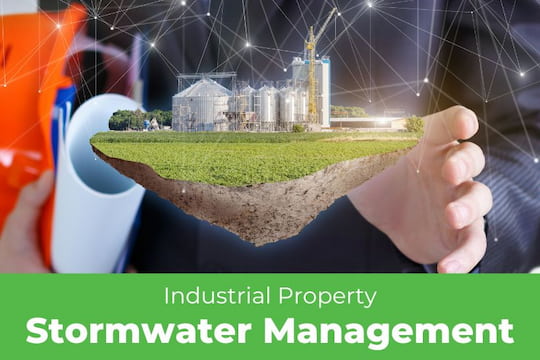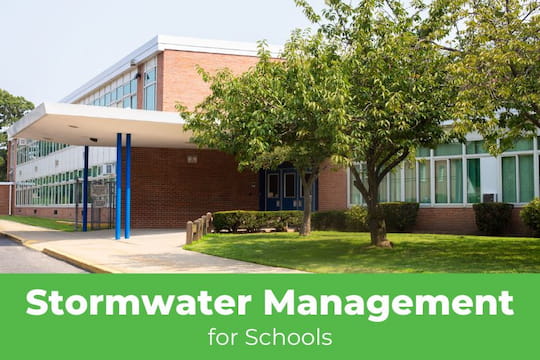When a community of homes is newly constructed, the developer and contractor are responsible for designing and implementing an effective stormwater management system that prevents flooding and water pollution from unfiltered runoff. However, the obligation to maintain and keep the system in good repair usually passes on to the Home Owners Association once the development has been completed.
Legally, since the association did not do the original design or construction of the stormwater management system, it typically cannot be held responsible for poor design. However, an association would likely be held liable for poor or negligent maintenance of the system and the resulting damages.
Stormwater drainage problems for associations come in many flavors, but the four issues below make a good starting point for building awareness, knowing where to look for problems, and formulating a plan for the next steps.
Clogged or Blocked Basins

Storm drains and catch basins on private roads within the association’s area must be unobstructed and adequately maintained so that they can keep the streets clear of stormwater as originally designed.
Clogged basins usually have less to do with system design and more to do with maintenance. They cause flooded streets, which become a nuisance for residents. Areas of standing water can also breed mosquitoes.
Stormwater systems commonly have catch basins and track drains to capture stormwater. It’s easy to spot problems because aside from pooling water and flooded areas, the basin will likely have trash, debris, vegetation, or other items that keep water from freely flowing through the drainage system.
Be on the lookout for other issues, such as sinkholes in paved areas around the catch basin. This situation needs to be addressed as soon as possible to prevent more severe and expensive consequences.
The association’s area of responsibility may include other components in the overall stormwater management system, such as ditches, swales, or stormwater drains located on individual property lots.
Keeping catch basins clear before the storms come is key because stormwater drainage problems for associations can potentially result in legal liability.
For example, an association could make landscaping decisions that involve changes to the topographic nature of common areas.
When done incorrectly without proper drainage, landscape changes can cause excess stormwater to drain onto neighboring lots and create pooling or flooded areas. This issue touches on another significant stormwater drainage problem.
Improper Slope of Roads and Driveways

The improper sloping of driveways and roads contributes to community flooding. The flooding usually stems from problems in the original design, although changes in landscaping that don’t take stormwater drainage into account can also contribute.
The resulting lack of efficient drainage can cause residents to experience pooling water in their yards or collecting water in common areas of lawn next to streets.
A design issue giveaway is often streets that were paved at a level that sits higher than the end of property driveways. The association can remedy this problem to a degree when the community repaves the streets in some cases.
The association can also benefit from hiring an experienced design engineer to assess problem areas and recommend additional ways to enhance the existing stormwater management system and offset any other design flaws.
Poorly Graded Landscaped Areas
Landscaping plays a prominent role in assisting the proper drainage of stormwater. Poorly graded grassy areas and other landscaping can lead to significant problems with flooding. After a rain, any observed ponding in low-lying landscape areas or areas of standing water indicates drainage problems.
Often, the solution lies in reworking the affected areas to include a stormwater management solution such as a grassed swale.
This procedure consists of creating a channel that allows stormwater to collect and drain out of the immediate area. The channel contains vegetation suited to protect the ground from soil erosion over time, which keeps it performing correctly.
Another essential maintenance step is mulching in landscaped bed areas to increase stormwater drainage. Compacted soil can keep water from soaking in, causing ponding. Mulch increases the soil’s ability to absorb and hold water instead of collecting water on the area’s surface.
Lacking an Effective Maintenance Program

Maintaining a stormwater system needs to involve regular, periodic inspections. This process helps identify problems before they start and prevent damage to roads, driveways, sidewalks, and other areas.
Unfortunately, a new association might not have a set program, or an existing program fails over time due to association staff turnover and other administrative issues.
Creating or rounding out a regular maintenance plan needs to happen before the rains come and can include the following, among other items specific to the current stormwater management system and devices in place.
- Inspecting common areas and easements
- Removing leaves, vegetation, trash, and other debris from catch basins and other drainage devices
- Restoring eroded soil in areas critical to channeling stormwater
- Repairing cracks or damage to concrete areas
- Creating slopes in open grassed areas for proper water drainage
A copy of construction plans for the site, CCR maintenance guidelines, and drainage reports can provide a wealth of information on the existing system design, devices and components, and the intended maintenance plans.
If these items no longer exist or are unavailable, an experienced drainage engineer can help survey and assess the stormwater management system, highlight risk areas, and make recommendations for regular maintenance and improved operations.
Get Help Before You Need It
When an association properly manages and maintains its stormwater management systems, this greatly enhances the safety and value of the community.
Taking a proactive stance to managing the stormwater system can pay off by minimizing risk while maximizing safety and property values for the community.
Stormwater drainage problems for associations don’t always happen. Still, when they do, Catch-All® Environmental can help sort through repair and maintenance issues to get the system operating safely and effectively.
Stormwater systems can be complex and expensive to maintain. Our depth of knowledge and experience helps us understand and remedy the myriad issues that can arise with stormwater management systems and get them back on track.













.jpg)


